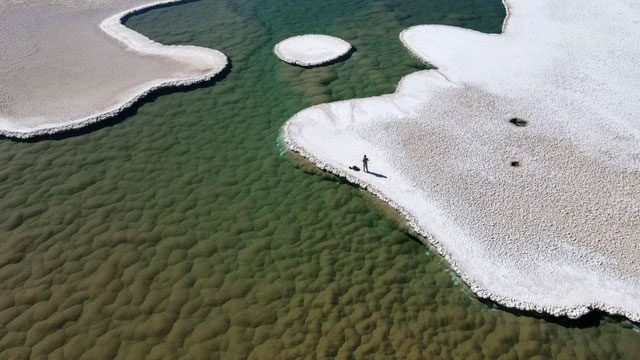A “Lost World” Discovered in the Atacama Desert, Unveiling Secrets of Life on Mars and Ancient Earth.
Crystal-clear wetlands and vast salt flats, resembling the landscapes of Mars in Argentina’s Puna de Atacama, have formed a unique ecosystem unlike anything scientists have seen on Earth.

Crystal-clear lakes interspersed with salt flats in Atacama are also what scientists often describe about ancient Mars – (Photo: BRIAN HYNEK)
Part of the Atacama Desert, which spans several South American countries, Puna de Atacama is extremely inhospitable, characterized by an arid environment and sunlight more intense than anywhere else on the planet.
Most of Atacama is regarded as a “dead zone” of Earth, where typical organisms cannot survive, with only a few extreme species scattered throughout.
Scientists stumbled upon the “lost world” after spotting unusual images in satellite photographs.
The exploration team, led by Associate Professor Brian Hynek from the University of Colorado Boulder and microbiologist Maria Farrias, founder of the environmental consulting company PunaBio, conducted a field trip in the area.
They confirmed that the bizarre features seen from space are indeed a unique ecosystem reminiscent of an extraterrestrial world in science fiction.
They discovered twelve shallow, crystal-clear lakes surrounded by mountains, where they found “living mounds” approximately 4.6 meters in diameter, composed of layered green microorganisms.
These could be stromatolite bacterial communities, whose secretions have solidified into rock layers.
Previous studies suggested that this peculiar organism may have existed on Earth around 4 billion years ago, during the Hadean Eon—a time described as a molten sphere.
In other words, if we want to envision the first living organisms present on Earth during that “hellish” period, as well as on Mars 3 billion years ago—a time NASA believes may have harbored life—then we should look at what has just emerged in Atacama!
They are not organisms that exist in “life-sustaining conditions” as we typically use as a benchmark when searching for extraterrestrial life.
The living mounds are submerged in highly saline, acidic waters, heated by some of the most intense solar radiation on Earth.
Two main types of bacteria have been identified within these living mounds, including cyanobacteria, which are still photosynthesizing vigorously, and single-celled organisms known as archaea.
“If fossilized life were found on Mars, it would look like this. Understanding this modern community on Earth could tell us what to search for in Martian sediments,” explained Associate Professor Hynek.





















































